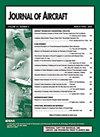风洞和栅格分辨率在大涡模拟中对高扬程通用模型的影响研究
IF 2.1
3区 工程技术
Q2 ENGINEERING, AEROSPACE
引用次数: 0
摘要
本文描述了可压缩大涡模拟(LES)求解器在高升力通用研究模型(CRM-HL)着陆构型上的应用,这是一种复杂的外部气动流动构型,在高升力装置上有展开的板条、襟翼、通流机舱和相关的支架/整流罩。体积马赫数为(0.2),基于空气动力弦的平均雷诺数是典型的风洞实验([公式:见文本])。与以前的工作相比,这些模拟的一个关键发展是,这项工作有助于建立LES方法对雷诺数和飞机构型的鲁棒性。之前的研究主要集中在日本宇宙航空研究开发机构的标准模型上,该模型的雷诺数比目前的CRM-HL研究要低,机翼/板条前缘曲率比CRM-HL几何形状更小,这导致前缘压力吸力峰值值更低,这两者都导致网格分辨率要求不那么严格。在这些LES模拟中,采用了代数平衡壁建模方法以及Smagorinsky子网格尺度模型的动态实现。计算是在自由空气环境下进行的,也包括风洞设施在七个迎角和五个网格分辨率水平下进行的,范围从[公式:见文本]百万控制体积。在自由空气条件下,随着网格的逐次细化,解对网格的敏感性降低,并随着网格的细化,系统地接近实验升力系数数据,其中15亿控制体积的情况与校正后的实验数据非常吻合。自由空气和风洞模拟均预测了一种较大的舷内节失速和俯仰力矩曲线下折的失速机制,两者与实验结果一致。模拟的准确性通过综合力/力矩、表面压力和表面表面摩擦可视化的比较来评估。charLES求解器的图形处理单元(GPU)加速导致易于处理的周转时间,使LES成为航空航天工业设计周期中的有用工具。流动求解器的最新GPU加速使得LES解决方案在600个GPU内核上在大约5小时的壁时间内可以实现相关高升力飞机流动的高度精确的升力/阻力/力矩。本文章由计算机程序翻译,如有差异,请以英文原文为准。
Wind Tunnel and Grid Resolution Effects in Large-Eddy Simulation of the High-Lift Common Research Model
This paper describes the application of a compressible large-eddy simulation (LES) solver to the flow over the High-Lift Common Research Model (CRM-HL) in landing configuration, a complex external aerodynamic flow configuration with deployed slats, flaps, a flow-through nacelle, and the associated brackets/fairings on the high-lift devices. The bulk Mach number is (0.2) and the mean-aerodynamic-chord-based Reynolds number is typical of a wind tunnel experiment ([Formula: see text]). A key development in these simulations relative to previous work is that this work serves to establish robustness of LES methods to Reynolds number and aircraft configuration. Previous studies focused on the Japan Aerospace Exploration Agency Standard Model, which featured a nearly [Formula: see text] lower Reynolds number than the present CRM-HL investigation and less aggressive wing/slat leading-edge curvature than the CRM-HL geometry, which led to lower leading-edge pressure suction peak magnitudes, both of which led to less stringent grid resolution requirements. In these LES simulations, an algebraic equilibrium wall modeling approach is employed along with a dynamic implementation of the Smagorinsky subgrid-scale model. The calculations are carried out in both a free air setting and one that includes the wind tunnel facility at seven angles of attack at five grid resolution levels, ranging from [Formula: see text] million control volumes. In free air, the solutions show decreasing sensitivity to the grid with each successive refinement level and systematically approach the experimental lift coefficient data as the grid is refined, with the 1.5 billion control volume case showing excellent agreement with the corrected experimental data. The simulations in both free air and in the wind tunnel predict a stall mechanism featuring a large inboard juncture stall and a nose-down break in the pitching moment curve, both of which agree with the experimental observations. The accuracy of the simulations is assessed via comparisons of integrated forces/moments, surface pressures, and surface skin friction visualizations. Graphics processing unit (GPU) acceleration of the charLES solver results in tractable turnaround times that make LES a useful tool in the aerospace industry design cycle. Recent GPU acceleration of the flow solver has made LES solutions that are highly accurate in lift/drag/moment for relevant high-lift aircraft flows achievable within about 5 h of wall time on 600 GPU cores.
求助全文
通过发布文献求助,成功后即可免费获取论文全文。
去求助
来源期刊

Journal of Aircraft
工程技术-工程:宇航
CiteScore
4.50
自引率
31.80%
发文量
141
审稿时长
6 months
期刊介绍:
This Journal is devoted to the advancement of the applied science and technology of airborne flight through the dissemination of original archival papers describing significant advances in aircraft, the operation of aircraft, and applications of aircraft technology to other fields. The Journal publishes qualified papers on aircraft systems, air transportation, air traffic management, and multidisciplinary design optimization of aircraft, flight mechanics, flight and ground testing, applied computational fluid dynamics, flight safety, weather and noise hazards, human factors, airport design, airline operations, application of computers to aircraft including artificial intelligence/expert systems, production methods, engineering economic analyses, affordability, reliability, maintainability, and logistics support, integration of propulsion and control systems into aircraft design and operations, aircraft aerodynamics (including unsteady aerodynamics), structural design/dynamics , aeroelasticity, and aeroacoustics. It publishes papers on general aviation, military and civilian aircraft, UAV, STOL and V/STOL, subsonic, supersonic, transonic, and hypersonic aircraft. Papers are sought which comprehensively survey results of recent technical work with emphasis on aircraft technology application.
 求助内容:
求助内容: 应助结果提醒方式:
应助结果提醒方式:


